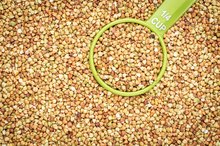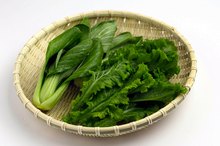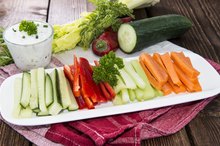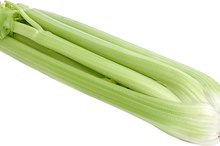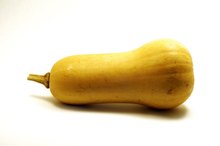Nutritional Value of Cooked Celery
Raw celery is a popular salad ingredient or snack that you can eat with dips, but cooked celery is another healthy choice. It is an easy side dish to prepare, or you can add it to casseroles, soups, sauces and other dishes for extra flavor and nutrients. Cooked celery provides the most health benefits as part of an overall balanced diet that includes a variety of vegetables.
Calories and Macronutrients
Cooked celery, prepared without added fat, has 27 calories per cup. It has 6 grams of total carbohydrates, including 3.5 grams of natural sugars, 1 gram of protein and almost no fat. Celery and other low-calorie foods can help you lose weight or prevent weight gain because you can eat large portions of them without going over your calorie limit. Celery is cholesterol-free. Watch out for added fat during cooking -- oils and fats contain over 100 calories per tablespoon, so they can send your calorie intake soaring.
- Cooked celery, prepared without added fat, has 27 calories per cup.
- Celery and other low-calorie foods can help you lose weight or prevent weight gain because you can eat large portions of them without going over your calorie limit.
Dietary Fiber
The Health Benefits of Kasha
Learn More
Cooked celery provides 2.4 grams of dietary fiber per cup. Dietary fiber lowers your cholesterol and may help you control your weight because it is a hunger-suppressing nutrient, according to the 2010 Dietary Guidelines from the U.S. Department of Health and Human Services. Recommendations for fiber intake are to get at least 14 g per 1,000 calories that you eat, but the typical American gets less than half of that amount. Consuming more celery means you'll enjoy the many health benefits -- including digestive health and lower cholesterol -- associated with a diet rich in fiber.
- Cooked celery provides 2.4 grams of dietary fiber per cup.
- Consuming more celery means you'll enjoy the many health benefits -- including digestive health and lower cholesterol -- associated with a diet rich in fiber.
Sodium
Boiled celery has 136 milligrams sodium per cup, which makes it a low-sodium food, according to Colorado State University Extension. Low-sodium foods have less than 140 milligrams per serving. A high-sodium diet can cause high blood pressure and increase your risk for heart disease, stroke and kidney disease. The recommendation for healthy adults is a maximum of 2,300 milligrams sodium per day. If you add salt to your celery during cooking, it will have 490 milligrams sodium.
- Boiled celery has 136 milligrams sodium per cup, which makes it a low-sodium food, according to Colorado State University Extension.
- If you add salt to your celery during cooking, it will have 490 milligrams sodium.
Other Nutrients
Kidney Stones & Popcorn
Learn More
Cooked celery provides 426 milligrams potassium per cup. Potassium helps to regulate blood pressure, and healthy adults should get at least 4,700 mg per day, according to the 2010 Dietary Guidelines from the U.S. Department of Health and Human Services. Celery has 9 milligrams vitamin C, or 15 percent of the daily value, and 782 international units of vitamin A, which is 16 percent of the daily value. It has 33 micrograms folate, or 8 percent of the daily value.
- Cooked celery provides 426 milligrams potassium per cup.
- Celery has 9 milligrams vitamin C, or 15 percent of the daily value, and 782 international units of vitamin A, which is 16 percent of the daily value.
Related Articles
References
- U.S. Department of Health and Human Services; Dietary Guidelines for Americans, 2010; January 2010
- Celery, raw. FoodData Central. U.S. Department of Agriculture. Published April 1, 2019.
- Anderson GH, Soeandy CD, Smith CE. White vegetables: Glycemia and satiety. Adv Nutr. 2013;4(3):356S-67S. doi:10.3945/an.112.003509
- Yusni Y, Zufry H, Meutia F, Sucipto KW. The effects of celery leaf (apium graveolens L.) treatment on blood glucose and insulin levels in elderly pre-diabetics. Saudi Med J. 2018;39(2):154-160. doi:10.15537/smj.2018.2.21238
- Eid HM, Nachar A, Thong F, Sweeney G, Haddad PS. The molecular basis of the antidiabetic action of quercetin in cultured skeletal muscle cells and hepatocytes. Phcog Mag 2015;11:74-81 doi: http:10.4103/0973-1296.149708
- Youl, E., Bardy, G., Magous, R., Cros, G., Sejalon, F., Virsolvy, A., Richard, S., Quignard, J., Gross, R., Petit, P., Bataille, D. and Oiry, C., Quercetin potentiates insulin secretion and protects INS‐1 pancreatic β‐cells against oxidative damage via the ERK1/2 pathway. British Journal of Pharmacology, (2010) 161: 799-814. doi:10.1111/j.1476-5381.2010.00910.x
- Tang GY, Meng X, Li Y, Zhao CN, Liu Q, Li HB. Effects of vegetables on cardiovascular diseases and related mechanisms. Nutrients. 2017;9(8). doi:10.3390/nu9080857
- Folate: Fact Sheet for Health Professionals. National Institutes of Health, Office of Dietary Supplements. Updated 2020.
- Vitamin A: Fact Sheets for Health Professionals. National Institutes of Health, Office of Dietary Supplements. Updated 2020.
- Fact or myth: does celery really have negative calories?. Carleton University Dining Services. Updated 2017.
- Allergenic foods and their allergens, with links to informall. University of Nebraska-Lincoln Institute of Agriculture and Natural Resources. Updated 2014.
- Why vitamin K can be dangerous if you take warfarin. Cleveland Clinic. Updated 2019.
- Barone M. Celery juice: Are the benefits real?. UC Davis Health. Updated 2019.
- Combs M H, Ernst M. Celery and celeriac. University of Kentucky College of Agriculture, Food and Environment Cooperative Extension. Updated 2019.
- Celery. University of Nebraska Lincoln Extension.
Writer Bio
Natalie Stein specializes in weight loss and sports nutrition. She is based in Los Angeles and is an assistant professor with the Program for Public Health at Michigan State University. Stein holds a master of science degree in nutrition and a master of public health degree from Michigan State University.
